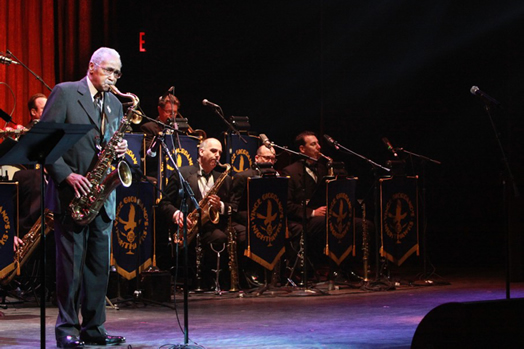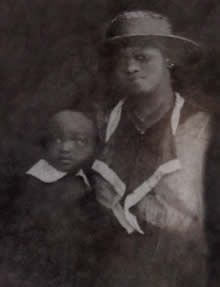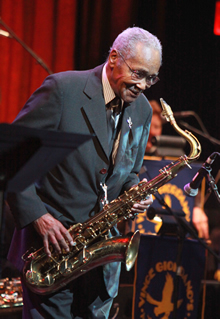Allegro
“I’d rather be here than anyplace I know”
Fred Staton at 102
Volume 117, No. 7July, 2017

Fred Staton with fellow musicians at the Apollo Theatre in 2010, when Staton was 95. Seven years later, Staton is still playing. Photo: Jerry Lacay
On a warm Sunday afternoon, Mr. Fred Staton sits, poised and alert in his comfy chair. He has graciously agreed to an interview and invited me into his home. At age 102, he might be expected to balk at such an idea, but he has been nothing if not enthusiastic and business-like about the entire matter. My fears about disrupting his routine don’t seem to register, as he waits politely for me to turn on my digital voice recorder and get to work.
The apartment is a well-lit one bedroom in the Riverdale section of the Bronx. Staton, a jazz saxophonist and native Pittsburgher, has lived here since 1972. There’s a home attendant who comes in every day for several hours to cook and straighten up, but Staton often performs many of these tasks himself. What is perhaps even more remarkable: he is still playing the saxophone, and performs in public several times a year. A bout with dehydration landed him in the hospital last winter, but he is feeling stronger these days and, on the afternoon I meet him, laughs, tells jokes and is in high spirits throughout.
Staton is one of only seven members of Local 802 who are 100 or older. “I was born in 1915,” says Staton as we settle in, “and my mother’s name was Anna Finch. That’s her in the photo behind you.” I turn and see an unframed image of a woman in a tailored outfit, standing with a small boy at her side. The photo has darkened with age, but the faces are still visible.
“That’s me when I was four years old, in 1919. My mother’s people came from Brookneal, Virginia. Her father was a tobacco farmer. But she was born in Beaver Falls, Pennsylvania.”
Stanton explains how his parents both ended up in Lawrenceville, now part of greater Pittsburgh, because of the McConway & Torley steel foundry there.
The Statons lived in a single family, wood frame house, on a tree-lined hillside. They were one of three black families in the neighborhood, which was mostly Polish and Lithuanian. Fred, who had three younger sisters (another sibling, a boy, died in infancy), attended McKinley Elementary School. Staton’s sister, Dakota, went on to international acclaim as a jazz vocalist beginning in the late 1950s.
McKinley was integrated, but there was no music program. Staton, who did not know his grandparents well, does not recall any other musicians in the family before he and his sister came along. “My mother tinkered with the piano,” he remembers, “but that was it.”
Staton’s memory is sharp. He recalls that after his family moved to the Homewood neighborhood, he began singing in a quartet in their local Baptist church.
He also remembers that a man named Thomas Vaughan helped to secure a sponsor for a kid’s band where Staton had his first experiences with instrumental music. That association occurred around 1928, when Staton was 13.

Staton with his mother, Anna Finch, circa 1919.
I ask if the saxophone was his first instrument. “Now that’s a story!” he tells me, as his laughter fills the room, and he continues to laugh aloud as he tells the tale. “During my early teens,” he begins, “there were no talking movies, just the silents. But in the movie theatre, after sound came in, they would show Duke Ellington’s band, and Sonny Greer with all of this paraphernalia behind him, all of his drums just dwarfing him. He had chimes and timpani and all that. So I said, ‘I want to do that.’ And, this man Vaughan, he got this company to supply us with instruments and lessons. Since I was so passionately obsessed with Sonny Greer, I went for the drums. The band did several engagements, and after the gigs were over, the guys would pack up their instruments and be gone…with the chicks! And me, I’m still here…packing up the drums! So, I packed up the drums and went back to the practice room where we kept the instruments, and…there was the saxophone. Someone didn’t pick up the saxophone. Of all the instruments – they had trumpets, trombones, tubas – but no one picked up the saxophone! This was a tenor…I’ll never forget. A silver Buescher tenor saxophone. And I put the drums back, put them aside. And I said, ‘On second thought, I’m gonna do that!’”
Staton attended Westinghouse High School in Homewood and was classmate with Billy Strayhorn.
“In 1933 I put a band together for the annual revue show, and Billy was the pianist,” he recalls. “And in 1935, we did a show called ‘Fantastic Rhythm,’ and Billy premiered his tune, ‘My Little Brown Book.’ I believe that was the first public performance of that number.”
Like many musicians, Staton worked in and out of music to support himself.
The foundries provided a livelihood for the larger community, but the myriad Pittsburgh nightclubs were a big draw. By the late 1930s, Staton, now with a family to support, had moved into an apartment in the housing projects on Bedford Avenue in the Hill District, Pittsburgh’s bustling center of black life. The projects were erected on the site of Greenlee Field.
“We were one of the first families to move into those projects. There had been a graveyard there, originally – my uncle was buried there. They exhumed the bodies and Gus Greenlee built the ballpark.” It was there until 1938.
We talk briefly about Negro Leagues baseball, and the Hill District’s Mr. Big, Gus Greenlee – the racketeer-philanthropist who owned the premier jazz venue, the Crawford Grill, and sponsored a Negro Leagues team, the Pittsburgh Crawfords.
“I used to see Satchel Paige, Oscar Charleston and Josh Gibson play all the time when I was a kid,” he says, and reminds me that Greenlee Field was the first black built and black owned major league baseball field in the United States.
Staton was affiliated with a variety of local bands, including the Fred Avrette Orchestra, and witnessed performances by many of the seminal black big bands, including those of Jimmie Lunceford, Earl Hines and Louis Armstrong, first hand.
Regarding his influences, “I loved Johnny Hodges, but since I played tenor, I was a Coleman Hawkins man,” says Staton. Swing continues to be his milieu…“to this day,” he tells me.
Pittsburgh still has a rich musical culture, and the city has produced its share of greats. While on the Hill, he rubbed elbows with local heroes such as Chu Berry, Hines, Roy Eldridge and Billy Eckstine. I ask him if he ever sat in with the Eckstine band, which had a long run there.
“Well, before I moved to the Hill, we were neighbors,” says Staton. “Billy was in my area…he lived in East Liberty, and I was in Homewood, so not far from each other.”
But did he play with Eckstine? Well, he told me, “I never played with Eckstine. I associated with him…and I drank with him…and I smoked pot with him!”
With America’s entry into World War II, Staton was drafted, but was designated III B (“deferred both by reason of dependency and occupation essential to the war effort”), as he was now a first-class welder at the Dravo Shipyard on Neville Island.
“I wanted to go,” remembers Staton. “But they didn’t take me because they needed welders. Then the war broke up the big bands, and a lot of the musicians were drafted. So as a result, they had to pick up guys from different places. And Fred Avrette played at the Savoy; it was a Saturday night thing. It was about a 12-piece band. I worked in the shipyard five days, and on Saturdays I played the gig. And that went on probably for about four years.”

Photo: Jerry Lacay
Staton led a trio that was showcased in front of the orchestra during Avrette’s stage shows. He named the group the Three Tempos, and they began getting in work in clubs and bars in the Pittsburgh area. That unit, which eventually expanded to four musicians, later gigged in places like Atlantic City, New Jersey and Wilmington, Delaware.
The post-war period saw Staton working in the restaurant business, which eventually brought him to New York. But music was still a big part of his life.
“I got a position at Lincoln Center, at the Vivian Beaumont Theatre, and I worked my way up to First Maître d’ there. With Lincoln Center, I was lucky enough to be on a five-day schedule, so I could pick up gigs on Saturday nights. So, every Saturday I was out there playing. Sometimes Friday and Saturday. I didn’t sleep much!” It was around this time that Staton joined Local 802. His official initiation date is listed in the union’s records as March 17, 1954, but he believes he may have been in the black Pittsburgh local, 471, as early as 1935.
Much later, Staton became a premier member of the Harlem Jazz and Blues Band, an ensemble founded by Dr. Al Volmer, which has been active since 1973, and is still going strong. The band’s ranks have included such luminaries as Eddie Durham, Doc Cheatham and Happy Caldwell. Volmer secured multiple tours over the years, and as a result, Staton has been to Sweden, Denmark, Japan and China.
I ask if he has plans to go back to any of those places. “No plans,” he says, smiling, “I’m retired.”
Towards the end of my visit, Staton suddenly remembers an early engagement he has failed to mention.
“I just remembered my first real gig as a musician,” he says.
“That first job, if you can call it a job, was with a carnival. It was about 1929 or 1930. And what we would do, they would put us in the back of this truck, and we would blast out and ride through the town advertising for the carnival. It was only two weeks. The name of the carnival was the Harry Copping Shows.”
“After we did the advertising part, we played behind the minstrel show that was part of the carnival. It was called the Pork Chop Review. They had tap dancers and comedians and exotic dancers. I learned to play the music from another alto player; he was older than me. He could take a board and make a reed out of it.”
I ask him for details on the style of music. “It wasn’t too difficult. All I had to do was play two notes,” he says, “The same two notes!”
This jogs his memory a bit more, as he recalls events from almost 90 years ago.
“Oh, yeah…also…it was a tent show. I remember, because the musicians put up the tent! Oh, and one more thing,” he says, laughing heartily, “we never got paid!”
As the hour winds down, he shows no sign of fatigue, and I ask him about his current apartment.
“I love this place,” he says. “My grandson, Richard, comes to see me often. I am very happy here. I’d rather be here than anyplace else I know.”
And, then, the inevitable question:
“To what do you attribute your longevity, Mr. Staton?”
“My longevity?” he asks, with a wry smile. “Well, that lady behind you, Anna Finch, she had something to do with it. She took me to church. And the main thing I attribute it to is just two words: spiritual truth.
I make my goodbyes. There’s a lot more to discuss. It’s hard to cram a century of human experience into a single hour.
“Come back,” he tells me. “You’ve barely brushed the surface.”
